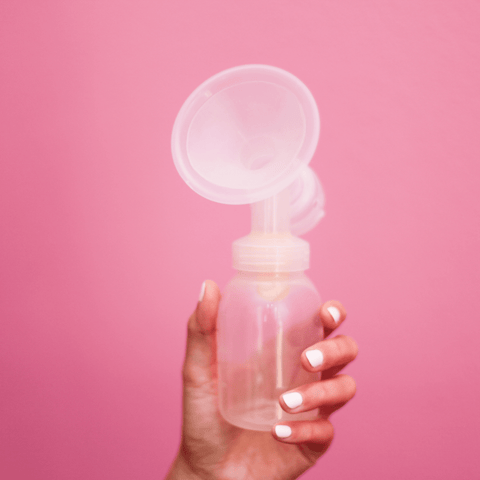How to Tell if You Have Elastic Nipples and What You Can Do About Them
Mommy Care Team
Breasts Come in Different Sizes, and Nipples Come in Different Shapes
Ever wondered why it can be difficult to find the right bra size? Human breasts aren’t the same across the board. They come in different sizes -- yes sometimes one person might have two different sized breasts. Then, there’s our nipples. Nipples come in different shapes. Some are larger, others are smaller. Some nipples are flat. Some are inverted. And others still are elastic.
What are elastic nipples?
Almost all skin has some elasticity to it. Relaxin, a hormone that increases during pregnancy and postpartum, is known for allowing our hips and pelvic floor to stretch. It is also responsible for making our nipples stretch a bit. This enables a baby to latch properly, drawing your nipple fully into their mouth, thus being able to nurse. Without this stretching and/or swelling, nursing a baby could be quite painful.
Most nursing moms are not fully aware of the extent of this change in our nipples because it happens within our babies’ mouths. We don’t actually see the process. If you are pumping however, the difference is quite clear. When you watch a breast pump work, you can see the tissue being drawn into the flange of the breast pump under suction.
So how much elasticity is normal and when does too much become a problem?
When too much of your breast tissue is drawn into a flange, it can become painful, inhibit your letdown, and therefore make pumping an unpleasant and unproductive experience. Elastic nipples will be drawn all the way down through the tunnel of the flange and actually press up against the valve.
If this is happening when you pump, it could mean that you have elastic nipples, or it could mean that you need a different flange size. The best way to determine whether you have overly stretchy tissue is to seek a professional flange sizing consultation. A CLC or IBCLC will be able to help determine whether you are using the correct size flange. If the flange is too large, it will allow more of your tissue to be drawn into the tunnel mimicking this condition.

Moms with elastic nipples may also experience pain, swelling, dry or cracked skin, and an inability to fully empty their breasts.
What Can You Do if You Have Elastic Nipples?
The first thing is to relax. There is no real health risk, or potential problem for moms who have elastic nipples beyond pain or mild swelling of your breast tissue. The second thing, if your current pumping situation is not working for you, or not working optimally, try something different.
Breast Pump Cushions
The first thing we recommend is to schedule a professional consultation. Not only will this help to confirm whether you have more elasticity than normal, but you can also work together to alleviate the pain and swelling so that you can pump effectively and without pain. This may involve using a series of different breast pump flange sizes in combination with other therapies to reduce painful swelling of your breast tissue.

BeauGen Breast Pump Cushions have become highly recommended as they help to hold back your breast tissue and prevent too much of it from entering the tunnel of your breast pump flange. Not only does it eliminate the pain of your nipple bumping up against the back of the tunnel or the valve, but it also eliminates painful friction against sensitive skin.
Use Lubrication:
Coconut oil and food safe lubricants are great aids for people who are pumping. The lubrication helps to eliminate friction which can become pretty painful for those with elastic nipples. Most breastfeeding safe lubricants are also moisturizing and can help to heal skin that has become raw or cracked due to friction. This is extremely beneficial as cracked nipples leave you more susceptible to conditions like thrush. If you use BeauGen Breast Pump Cushions, they can be used with lubricants. In fact, our Mommy Care Team Recommends it.
Try Turning Down the Suction
Sometimes this sounds counter-intuitive. We want to pump more milk so it might sound like a good idea to turn up the suction. For many moms more power isn't necessarily a good thing, and for some moms, it can be harmful. If using your pump is painful, you might want to try turning down the level of suction.
Can Moms With Elastic Nipples Breastfeed?
Yes! Absolutely! And many of them do. Actually, moms who breastfeed with elastic nipples might not even know that they have elastic nipples. This is because we don't normally go around testing our nipples for elasticity. It's when we up the suction on a breast pump that we notice our skin stretching more than what is considered normal.



5 comments
Hi Bethany – Yes! We have 2 products that moms have sworn by that help with their elastic nipples, BeauGen Cushions and EnduraFit Inserts. Both are flange inserts that are slightly sticky/tacky, which adhere to your breast tissue and help to hold back your nipples so that they do not stretch too far into the flange. The EnduraFit Inserts in particular have been noted by moms with elastic nipples to hold back even more elastic tissue. We have an authorized reseller of BeauGen cushions in the UK, but if you’d like to try EnduraFits, they are currently only offered on our shop in the US and we’ll ship to the UK. I’ll follow up with an email to discuss further!
I am 100 percent sure I have elastic nipples as no matter the flange size my breasts fill it and nipples and areola is pulled in to. My milk output is also really low. I live in the UK and use a medela symphony pump and size 24mm flanges … Can you help me
Hi Maria! You could try using a 21mm flange with the cushion to achieve a 19mm fit. Or, you could try try folding the tunnel of the cushions (like a turtleneck) inside of a 21mm flange to achieve closer to 17-18mm fit. You’re also welcome to email our mommy care directly so that we can help with your specific situation at pumped@beaugen.com.
Hi!! I have a 18 mm flange size and would love to use Beaugen cushions. Is there any way I can use them?
I have elastic nipples and your cushions have truly helped me continue pumping. Not only that but they help me effectively empty plus I now am 100 percent breastfeeding at 3 months pp which before I got the cushions I was having to supplement with formula because I just was in a lot of pain and could not empty properly. (I exclusively pump) These have truly helped me tremendously. I also use coconut oil and nipple creams to alleviate some of the tenderness but I’m grateful to have purchased these cushion. Thank you so much!!!